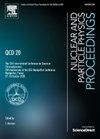Towards heavy double-gluon hybrid mesons with exotic quantum numbers in QCD sum rules
Q4 Physics and Astronomy
Nuclear and Particle Physics Proceedings
Pub Date : 2024-09-26
DOI:10.1016/j.nuclphysbps.2024.09.004
引用次数: 0
Abstract
The double-gluon hybrid meson configuration was recently proposed and investigated within QCD sum rules. In this talk, we discuss the color structures of the double-gluon hybrid meson and construct current operators with exotic quantum numbers and for two of the structures. In the framework of QCD sum rules, we consider the condensates up to dimension-8 at the leading order of for both charmonium and the bottomonium systems. The results indicate that the masses of the and charmonium double-gluon hybrid mesons are approximately GeV and GeV, respectively. As for the bottomonium systems, their masses fall within the range of GeV and GeV for the and channels, respectively. Additionally, the charmonium hybrids could be produced in the radiative decays of bottomonium mesons in BelleII experiment.
在 QCD 和则中实现具有奇异量子数的重双胶子混合介子
最近提出了双胶子混合介子构型,并在 QCD 和则中对其进行了研究。在本讲座中,我们讨论了双胶子混合介子的颜色结构,并为其中两种结构构建了具有奇异量子数 JPC=1-+ 和 2+- 的电流算子。在 QCD 和规则的框架内,我们考虑了粲和底铵系统的αs 前导阶的高达维度-8 的凝聚态。结果表明,1-+和2+-粲双胶子混合介子的质量分别约为6.1-7.2 GeV和6.3-6.4 GeV。至于底铵子系统,其 1-+ 和 2+- 沟道的质量范围分别为 13.7-14.3 GeV 和 12.6-13.3 GeV。此外,在贝列II实验中底铵介子的辐射衰变也可能产生粲杂质。
本文章由计算机程序翻译,如有差异,请以英文原文为准。
求助全文
约1分钟内获得全文
求助全文
来源期刊

Nuclear and Particle Physics Proceedings
Physics and Astronomy-Nuclear and High Energy Physics
CiteScore
0.40
自引率
0.00%
发文量
0
期刊介绍:
Nuclear and Particle Physics Proceedings is the premier publication outlet for the proceedings of key conferences on nuclear and high-energy physics and related areas. The series covers both large international conferences and topical meetings. The newest discoveries and the latest developments, reported at carefully selected meetings, are published covering experimental as well as theoretical particle physics, nuclear and hadronic physics, cosmology, astrophysics and gravitation, field theory and statistical systems, and physical mathematics.
 求助内容:
求助内容: 应助结果提醒方式:
应助结果提醒方式:


